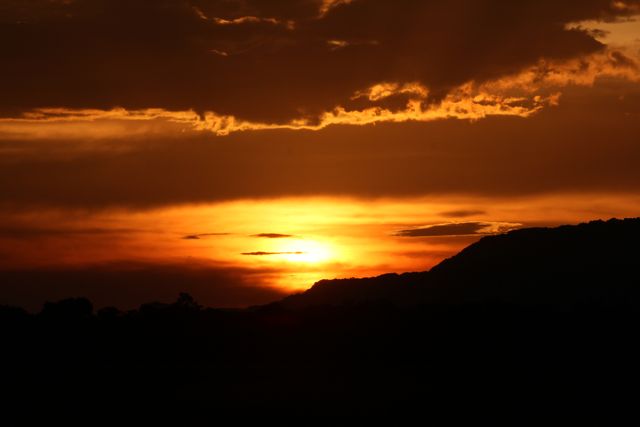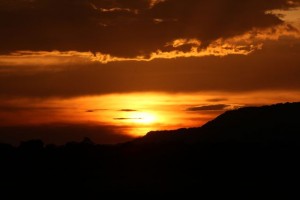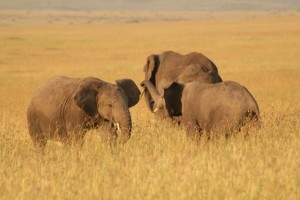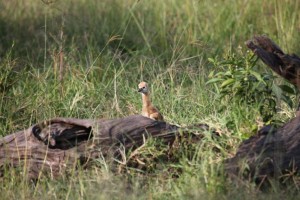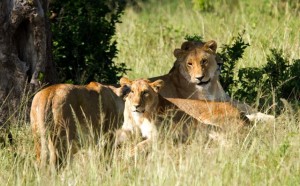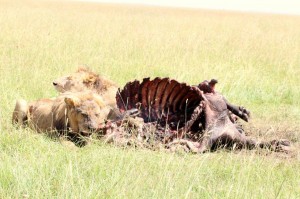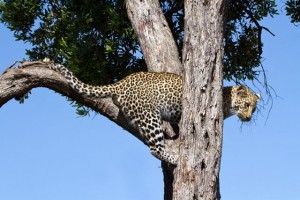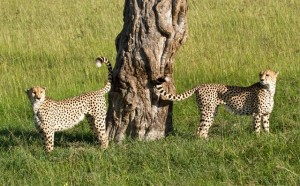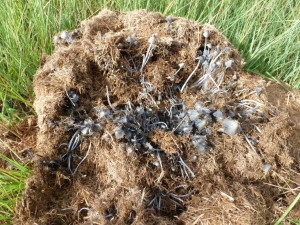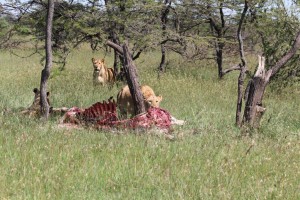Weather and grasslands:
We have enjoyed some lovely fair weather this month with stunning early morning sunrises. The early morning temperatures have been generally cool at 13/14°C and mid day temperatures were warm and averaged 31°C. January was a relatively dry month with little pockets of rain in the evenings with no more than 3-5 mm at a time. The Mara River appears at a low ebb and is slowly receding. On the 9th of January there was a spectacular full moon, that afternoon guests took sundowners and moon risers, and enjoyed watching the sun go down and 15mins later the moon rising in the East, magic. With clear skies above this is a truly great evening to have a candlelight diner out under a full sky. There is still good grass coverage still within the Bila Shaka, Rhino ridge and Musiara plains. The conservation areas that shadow the reserve where livestock is present have shorter grasses; these short grass plains are home to Thomson Gazelle and zebra.
Photo courtesy of Katie mcLellan
General game:
We have had wonderful sightings of lion, leopard and elephant galore around the marsh this month and lots of regular sightings of the big 5.
Elephant pass through the woodlands and camps under the fall of night as the Warburgia trees are still fruiting the feed off these fruit and spend long periods of time under trees while picking up an individual fruit with the fingers at the end of their trunk. The Teclea Nobilis is also fruiting and this has drawn many birds and Olive Baboons who also have a soft pallet perfect for this fruit. There are young elephant calves some of which are only weeks old in the grasslands of the Musiara and Bila Shaka plains.
Photo courtesy of Katie Mclellan
Giraffe wander effortlessly across the open plans from the Acacia and riparian woodlands to the Mara riverine woodlands. Large and dominant males move from one breeding herd to another. On Paradise and Topi plains topi with their two month old calves are in the shorter grass areas, having a narrow muzzle means they prefer the shorter grasses. The males and the stronger older males have Leks where females visit. On the western fan of Rhino ridge that leads onto Paradise Plains the males are rutting, they grunt, strutting about between their leks, male sparring sessions can last literally a matter of seconds.
Cokes Hartebeest with young that are also two months old are on Rhino Ridge, Topi plains and at Bila Shaka. Breeding herds of eland move back and forth between the conservation areas of Koiyaki and the reserve itself, there are some bachelor herds that float around here and one male has an incredible pair of horns, he is approximately 3-4 years old, when he reaches breeding age he will be an awesome animal. A large Eland bull can weigh in at 900/1,000 kgs
Blue Monkeys being more arboreal are seen in the woodland canopy, the Warburgia fruit are keeping them occupied. Olive Baboons are also spending more time in closed habitat where the trees are now fruiting this adds to their omnivorous diet. We have had comical sights of baboons in the canopy of fruiting trees and large bull elephant feeding on the fruit below, these large bulls often rock these large trees to shake the fruit down, the baboons get caught up in the trees, often shrieking and have to hold tight, on some occasions the baboons have been shaken out!! On the 21st at 4.30pm four Baboons were shaken and fell to the ground.
We have enjoyed regular sightings of male black rhino up on Paradise Plains and Rhino Ridge. There are two males that we regularly see and they like to browse on the native woolley caper bush.
Photo courtesy & copyright of Ann Aveyard
There are good numbers of defassa waterbuck between the woodland verges and the Marsh, being in the genus Kobus their ideal habitat is well watered grasslands and marshes, they do not live in water as the name describes but will take refuge there to escape predators. When times are hard lion will feed on them although they have an oily and scented skin and the so called waterproofing secretions of the waterbuck’s sweat glands produce an unpleasant odor in its meat, lion will often avoid them if other species are available, hyena is the other main predator of waterbuck and their calves.
A Caracal was seen near Rhino ridge on the West side on the morning of the 25th. These small cats can be found in dry savannah and woodland areas, scrubland and also in rugged terrain in mountainous regions. Caracals are superior jumpers and will catch ground birds in flight. Here in the Mara they have been recorded preying on Rock Hyrax and Thompson Gazelle fawns although they have a more varied diet depending on Habitat. There are many Banded mongooses about and they can also be seen in the camp surrounds.
The large herd of buffalo are within Bila Shaka and Rhino Ridge. There are two other smaller herds’ one near Naibor soit and the other on Paradise plains. The resident male buffalo remain within the grassland verges of the Musiara Marsh and Bila Shaka, the four new male lion have preyed upon three of these now. Cattle egrets can be seen flighting between them, even using resting buffalo as a perch!
The hippo pods in the Mara River have been very noisy this month, with water levels dropping the pods are getting more closely packed together, often causing a rift between dominant males, who are forced to get too close.
Photo courtesy of Steve Clark
January has proved a great month for birding with good water birds being seen in the Marsh and other watered byways. Crested cranes have chicks and one of them can be seen near the Causeway. Woolly necked storks have migrated and have been seen catching small fish. Great white egrets and a Rufus bellied Heron. On the east side of the Marsh early one morning there were about 5 or 6 Black Necked Herons all together and this is a site which is not often seen. Long Toed Plover are close to the causeway and also Ground hornbills have been seen collecting litter perhaps for nesting material.
Photo courtesy of Steve Clark
Bila Shaka / Marsh Pride
Joy was last seen on the north side of Rhino rRdge at the beginning of the month, The three sub adults (two males and a female) will often join up with Joy and her cubs or will be with another female who also moves about. The other three sub adults have not been seen for some time now and are presumed to be in the Paradise and Olkiombo area. On the afternoon on the 6th the two young males and two females were seen in the long grass north of the Marsh and had killed a warthog.
Photo courtesy of & copyrighted to Ann Aveyard
The four new younger males arrived in October/November last year and displaced Romeo and Clawed. Romeo had not been seen for some time now but our guides had a sighting of him up on Paradise Plain on a kill towards the end of the month. We are sad to report that Clawed met his end this month outside the Reserve. He had been seen again on the Musiara Plains on the 16th on a buffalo kill with the four Musketeers, he was in such bad shape that the other males obviously saw him as no threat and allowed him to share the kill. He was suffering from Sarcoptic mange and looking thin, his back hindquarters were very wobbly each he got up to move. He had trouble eating due to his lower right canine which was nearly smashed in probably from a kick of an ungulate approximately two years ago and this more than likely put him under much stress, it is true that lion are incredibly powerful and successful cats yet they are very susceptible to damage and injury. We shall miss his presence around the Musiara area but his lineage lives on.
Photo courtesy of Samuel Kiplangat
These new males have been named and are Hunter, Scar face, Morani and Skip. The gash on the right side eye on Scar face is still open but he is looking well enough and is still active. On the 30th at 4.00pm the wildlife services vet darted Scar face and treated his eye lid, there was a little infection although surprisingly the eye itself is fine. They have been feeding off buffalo with three so far of these old boys being taken down between Bila Shaka and Musiara. The two young females from the Marsh pride have been seen on Topi plains recently.
Notch and the four males are being seen in the Talek region and early on in the month they were seen feeding off a Hippo; they have also been feeding off Buffalo.
Five females and two cubs that are approximately three months old are also seen in the Talek area. As well as another two females a young male about two years old.
The single male that turned up last month is still in the area below the Bila Shaka river bed. He was limping on right front leg although looks in otherwise in good condition.
The two males have been seen once only on the other side of the Talek River and that was early on in the month. Another female with an eight month old cub has been seen near Olkiombo and she has been feeding of Thompson Gazelles.
Leopard
Olive and her 13 month old cub have been seen quite recently again but her older male cub has been seldom seen.
The female leopard near the croton thickets at Paradise has two cubs; a male and a female which are about 4 months old now. They are seen frequently and have been feeding off Thomson Gazelles and warthog. There was an excellent sighting of all of them on the 27th of this month. The large male at the end of the Bila Shaka river bed has been seen more often this month. Another male leopard who is really quite habituated has been sighted near to the Little Governors junction and is the last offspring of the IL Moran Female who died about a year ago. He is often at Lake Nakuru near the Marsh and close to Il Moran; he has been seen feeding off warthog and many Bush Buck. Within the woodlands between Il Moran Camp and the BBC site two remains of Bushbuck have been seen.
Photo courtesy of & copyrighted to Ann Aveyard
Cheetah
A female cheetah at paradise has been seen frequently and on the 26th she had killed a Thomson Gazelle. The two male brothers were last seen on the Olkiombo area, in the morning of the 19th they were seen with a young female warthog. Another female has been seen on the north side of Rhino ridge although with grass levels so high cheetah sightings have been a little slim this month.
A male is being seen from time to time at the Paradise croton crossing point up stream from the main rocky crossing point.
Photo courtesy of & copyrighted to Ann Aveyard
Walking in the Koiyaki Conservation Area.
Long grass is still prevalent in this area of Koiyaki with heavy dew on some cool mornings. Large numbers of elephant are seen passing through and are feeding on the grass coverage that is here. The acacia woodlands have not been affected and there is also evidence of young acacia growth. Most of the elephant dung contains grass and the whole fruit of the Warburgia tree which will germinate but out here they do not seem not to grow much more than ten feet perhaps due to insufficient water. Termite activity on elephant dung has brought up little mushrooms from the Termitomyces fungi spores. The Fungal Termite and the mutualistic fungi of the genus Termitomyces have a kind of symbiotic relationship and via SACCHARIFICATION which is the process of breaking a complex carbohydrate (as starch or cellulose) into its monosaccharide components which the termite can assimilate.
Photo courtesy of Patrick Reynolds
On the 26th an estimated 75 elephant were seen on the White highland ridge with three large males. Eland in small breeding herds of no more than 20, there is also a bachelor herd of 15 males with one young male that has a very good pair of Horns and is quite outstanding. There were three large bulls that frequented the acacia Gerrardii woodland near the Olare Orok River, on the 4th one was taken by lion
Photo courtesy of Patrick Reynolds
Zebra are more common here particularly in the shorter grass areas close to where livestock is present, in the last few days of January an estimated 150 Zebra were seen in the north of the conservation area. Lion are infrequently seen although there is the presence of four females and 9 cubs. On the 4th these lion were seen on a large bull eland they had killed earlier on in the night and they were being harassed by 24 Spotted Hyena, the sounds of the hyena could be heard from some distance. There is a herd of breeding buffalo an estimated 50 near the saltlick in the north of the conservancy there are also a few scattered old bulls with four often being seen together. Many Thomson Gazelles’ with a bachelor heard of over 30 males being seen just outside of the Mara reserve. Warthog are also being seen with piglet litters of more than 4 which is an indication that predation is less prevalent here. Breeding herds of impala are scattered throughout the woodlands and riverine pockets. A large bachelor herd of impala are near the Olare Orok River. Masai Giraffe can be seen throughout the woodlands and good numbers of them were seen recently. There are also some large males that wander form herd to herd, one of these males is very dark in colour almost to that of chocolate and is an attractive animal.

